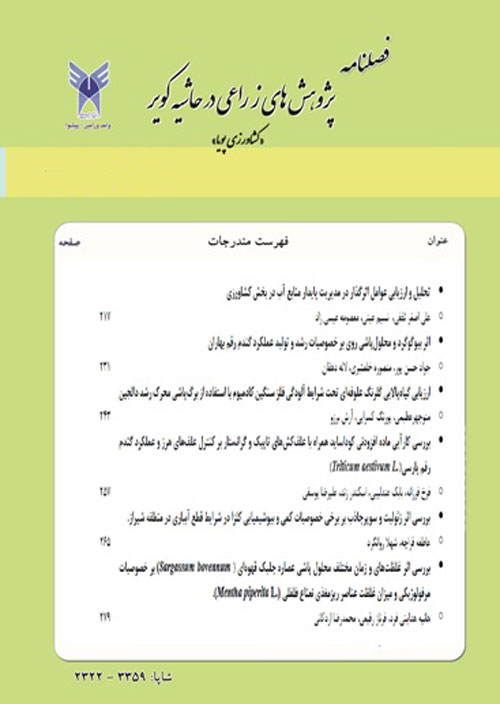Effect of defoliation time and quantity on yield and yield components of grain maize (Zea mays L.) hybrid KSC704 Under drought Stress
Author(s):
Abstract:
The physiological impact of source restriction on corn (hybrid SC704) yield formation due to water deficit stress was studied in Varamin during 2007-2008 and 2008-2009 growing seasons. The experiment was carried out in a complete randomized block design with split plot arrangement. In under stress plots, two short periods of water-holding were applied at V8 and tasseling growth stages. Defoliation treatments consisted of: control, cutting 1/3 of leaves at V8, cutting 2/3 of leaves at V8, and cutting 1/3 of leaves at tasseling and cutting 2/3 of leaves at teaseling. The grain yield of 8.9 t .ha-1 was attained by moderate irrigation which was a results of 16.4% and 27.3% greater biomass and harvest index compared to the water stress conditions. The water stress reduced the available assimilates during grain filling which resulted in reduction of grains per ear from 598 to 455, while increased the 1000-grains weight from 105 to 168 g. Positive and significant correlation between the grain yield and number of grains per ear indicated that this yield component is more important than individual grain weight for yield formation. The results showed that cutting 1/3 of leaves at tasseling not only did not decrease the dry matter accumulation but also increased the grain yield by more dry matter partitioning to grain filling process. Under water stress, late but scanty defoliation increased the water content of remaining leaves and their photosynthesis which resulted in higher grain yield.
Keywords:
Language:
Persian
Published:
Iranian Journal of Dynamic Agriculture, Volume:9 Issue: 4, 2013
Page:
299
https://magiran.com/p1506366
سامانه نویسندگان
مقالات دیگری از این نویسنده (گان)
-
Assess Effect of Biological Phosphorous Fertilizers and Micro Elements (Boron and Manganese) on Alfalfa Growth Curve Indices
Maryam Khirkhah *, , Ghorban Normohammadi, Mani Mojadam
Journal of Crop Nutrition Science, Autumn 2019 -
The Relationship between Every-other Furrow Irrigation and Foliar Application of Zinc on Physiological Indices in Two Sweet Corn Genotypes
Babak Peykarestan, Mehrdad Yarnia *, , Vahram Rashidi, Hossin Heidari Sharif Abad
Journal of Crop Nutrition Science, Summer-Autumn 2015



